
NEWS ALERT July - December 2014
December 15, 2014
Adopting at Christmastime?
A timely article entitled "Holiday adoption myth-busting at the SPCA" appeared in the Hamilton Spectator on Saturday (December 13).
The myth, of course, is that it's a bad idea to adopt at Christmastime.Many of us have in our heads those awful images of chaotic Christmas mornings and terrified kittens wearing bows who get ignored, lost amidst the excitement, and later discarded like unwanted gifts.
Anyone who cares about animals wants to avoid that kind of thing and this article provides some reassurance that the reality is generally quite different and that adopting this time of year can actually prove to be a good idea.
It starts off with the statement that "contrary to the myth, the holiday season is a fine time to take home a new pet - as long as everyone is prepared." And it offers some convincing arguments for holiday adoptions as well as some good ideas about how to think it through. Anyone considering adopting this season may want to read it.
The HBSPCA and all the rescue groups in Hamilton are working hard this December to find loving, forever homes for the cats and kittens in their care. They're doing this through special adoption events and through stories, pictures and some really cute and creative artwork on their Facebook pages.
Our Featured Cat for December is pictured below with the Grinch. We're hoping that this lovely green-eyed girl and many, many other rescued cats who are dreaming of being home for the holidays will get their wish, celebrate a Merry Christmas and purr their way through many Happily-Ever-After Years.
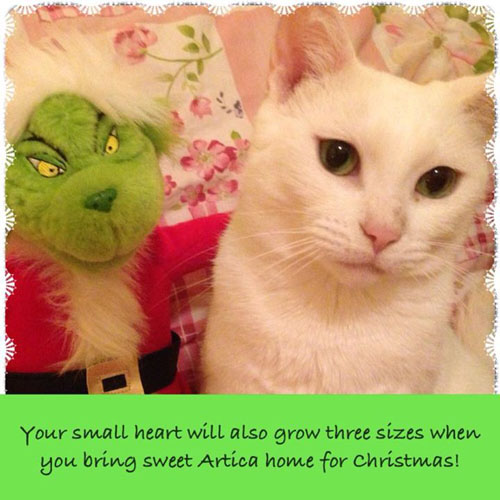
We hope that she and many other rescued cats will get their wish and celebrate a Merry Christmas and many Happily-Ever-After Years at home with their very own families.
ADOPTED DECEMBER 29, 2014
----
November 14, 2014
Saving the seriously injured cats relies on private funding
Like any organization funded by public money, Hamilton Animal Services (HAS) operates within limits; decisions made about what's best (most humane) to do have to be made according to budgets and according to rules about how taxpayer money is to be spent.
Every day cats arrive at HAS - last week (Nov. 3-9) there were 56 who came through those doors. Some are lost, some are strays; some are healthy, some are sick - and always there are a few in pretty bad shape.
Among last week’s arrivals was one who'd been picked up with an open, festering wound full of maggots. She'd been taken directly from where she was found to a vet who'd flushed out the wound and prescribed medication. But soon staff were noticing that the wound was infected again and that she wasn't doing well.
Another seriously injured one was a little tabby who'd been brought in with severe burns on his neck and face; he too was obviously suffering.
The most frequent reason given for making the decision to euthanize is "health" and sometimes that means, as it would have in these cases, that without extensive medical treatment, there was nothing in the future other than a prolonged, painful death. That weeks HAS stats listed “health” as the reason to euthanize in 10 (of the 11) cases. And it would have been higher by 2 (these 2) but for the privately funded organizations that stepped in.
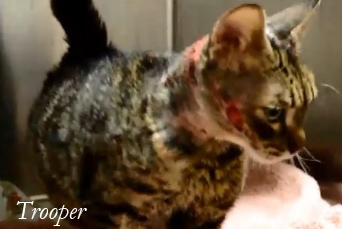 The sweet little burn victim got transferred over to the HBSPCA. A posting on that organization's Facebook today (Nov. 14) announcing that he's now goes by the name Trooper, reports that his burns are healing nicely and provides a video showing how well he's doing.
The sweet little burn victim got transferred over to the HBSPCA. A posting on that organization's Facebook today (Nov. 14) announcing that he's now goes by the name Trooper, reports that his burns are healing nicely and provides a video showing how well he's doing.
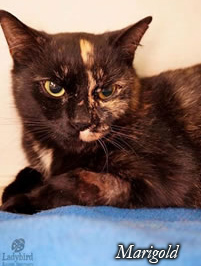 The lovely tortoiseshell with that awful wound, now named Marigold, got rescued by Ladybird Animal Sanctuary and updates on their Facebook report that, despite a lot of damage to the surrounding skin and muscle, her wound is healing well. X-rays taken showed that her hip was fractured and further x-rays will determine if the hip fracture will require surgery. But she's eating and using her litter box and she's likely to pull through.
The lovely tortoiseshell with that awful wound, now named Marigold, got rescued by Ladybird Animal Sanctuary and updates on their Facebook report that, despite a lot of damage to the surrounding skin and muscle, her wound is healing well. X-rays taken showed that her hip was fractured and further x-rays will determine if the hip fracture will require surgery. But she's eating and using her litter box and she's likely to pull through.
These two lucky cats will be forever indebted to the organizations that took them into their care.
And something every cat lover in this city needs to realize is that the HBSPCA, Ladybird, and all the other groups that take these high cost cats, and so many, many others too (the total so far this year is 1,790) into their care, face paying some pretty hefty bills - likely far exceeding what many (likely most) loving pet owners could afford to pay.
All of these groups are privately funded and, while it's true that unlike HAS they are free to decide how to spend their money and do commit themselves to spend whatever it takes to save these cats, they too don't have access to unlimited funds. They can't afford to say 'yes' to taking every desperate case that lands inside HAS. And the ones they do take into their care, ones as expensive as these two, can drain the bank.
The reality is that HAS, being publicly funded, is an organization that does what it can for these cats within the limits imposed. The other reality is that these privately funded groups rely on donations from the public. When they take cats like Trooper and Marigold into their care, they want cat lovers to follow the stories and think about donating. For anyone wondering where money donated to animal rescue organizations goes, tuning in to their Facebook pages is a good way to find out.
---
Oct 17, 2014
Some cats rescued but others at HAS remain anxious
He'd waited 3 fretful months at HAS knowing that, being black, 7 years old and needing dental work, his chances of getting out weren't good. But he just kept purring and hoping. And, on Thanksgiving weekend, a sponsor pledged a 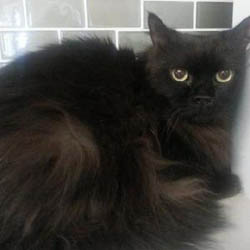 donation towards his vet bills, a volunteer driver picked him up and he was transported (in a carrying case borrowed from HAS) to one of the rescues. Finally able to relax, he's purring and hoping again - this time for his very own forever home.
donation towards his vet bills, a volunteer driver picked him up and he was transported (in a carrying case borrowed from HAS) to one of the rescues. Finally able to relax, he's purring and hoping again - this time for his very own forever home.
We're proud to have this fellow (Houston) posted now as the Featured Cat on our Adoption Page.
We're happy to report the additional good news that the only other remaining three cats who'd entered HAS as long ago as Houston did - back in July, have been rescued too.
As we celebrate this good news and cheer these lucky cats on, there's another reality that we mustn't lose sight of.
The stats from last week show that, while 36 cats were exiting happily to return to their owners or to go to rescues, 61 others were entering through the doors of HAS. If you do the math, the message is that:
Overcrowding is still a big problem!
What does this mean to the cats in cages at HAS today - the 25 cats who arrived back in August, the ones who joined them in September, and those who have arrived thus far in October? Well - they're in danger of being euthanized for "space" and waiting anxiously now to be rescued too.
---
Sept 30, 2014
Time up for a long-term resident?
She arrived on July 4; she's prettier than her photo and staff at HAS say that, while a bit shy and nervous, she's friendly when someone pets her. Their description of her ends with the comment: "she just needs time".
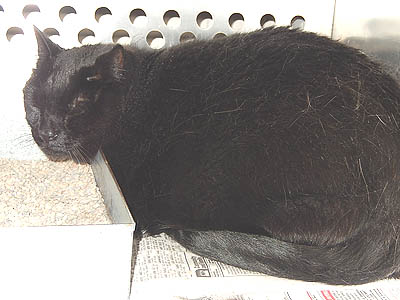
So things are pretty tense for this black girl right now. If it comes to the point when there are simply more cats inside than HAS can possibly house and care for, some will have to be sent out to be euthanized. As the longest term resident there, she's in danger of being among them. It will be a matter of who gets chosen. It may be her – or another long term resident – or maybe one of the sick or injured ones whose time is up.
Other than scream or cry or turn away and avoid looking at her photo (or the photos of the other 14 who have been there nearly as long), what can Hamiltonians do? Well, in the long term, there may be a long list of things to consider but one thought that comes to mind today is offering to foster or to make a donation that helps cover the costs of rescuing this one - or another of the long term residents.
---
Sept 5, 2014
Closed doors at HAS: What does it mean?
Several times this summer HAS has closed its doors.
Usually it's been for a day or so – just as long as required to get enough cats out so that none had to be euthanized/killed for "lack of space."
On one occasion (in mid-August), the doors remained closed for an entire week. People arriving during business hours carrying caged cats and kittens were told that, due to overcrowding, HAS wasn't able to accept them. They were understandably frustrated. Some became angry; one reacted by emptying a cage of kittens outside the building, leaving HAS staff with no option other than to chase and capture them and bring them inside.
The reasons HAS had not wanted to take them, and all the others arriving, inside were:
(1) They were already so overcrowded that even mothers and kittens were in danger of being euthanized. An alert had gone out to rescues and by the time HAS reopened, enough cages had been emptied that none of these little families (and, in fact, no cat) had to be killed for "space." (The cats featured on our adoption page for the month of September is one of these families whose lives were saved.)
2) There was a suspected case of ringworm and a genuine fear that this or another highly contagious illness, could spread through the shelter because the isolation room was no longer available. This suspected case was a mother and her kittens and this little family also was rescued by another group - one that had a way to isolate ringworm cases. By the time the shelter reopened its doors, the threat had past and the isolation room was cleaned and available again for use.
Anyone who recalls the pre-2011 era when overcrowding was so extreme that week after week adoptable cats (and kittens) were being euthanized for space and has in their heads the horrific images of times when outbreaks of disease resulted in "mass executions" of entire shelter populations will understand these reasons.
Yes, the current reality is vastly different. "Space" is now rarely identified as the reason to euthanize and a year-to-date 2014 euthanasia rate of 18% stands in encouraging contrast to the 50% rate in 2010. But overcrowding remains a serious problem throughout kitten season - which has just recently spiked and won't be subsiding for some time.
Instead of seeing HAS as the problem, it's time to start viewing what happens there as a reflection of a larger problem; one that every pet owner and cat lover in the city can help to solve. A Hamilton Spectator article dated August 26 gets across the seriousness of the situation and points out some things Hamiltonian can be doing to become part of the solution.
---
August 22, 2014
Spay/Neuter and Adoption Proposal
to go to city council
HAS has long been criticised for not addressing the urgent need for low-cost spay neuter and not running an adoption centre. An overhaul of the service planned for early next year, if approved by city council, would address both issues.
According to the CBC (22/08/14):
City council will vote this fall on whether to fix its “prehistoric” way of dealing with animals by…
Read more…
-----
August 1, 2014
What we need to know about
"The killing of cats at HAS"
A recent CBC news item, Hamilton animal services wants to kill fewer cats, ( July 17, 2014 ) served as a reminder that emotions still run high around HAS and "the killing of cats." Uninformed opinion continues to shape the public perception of what's going on at HAS.
It's hard to believe that such inflammatory labels as "extermination facility" are still appearing in the media and that statements are highlighted that fit that image.
Far more attention needs to be paid to the facts and to the details - to the continuing decline in the number of cats being euthanized there (250 to date (July 27th) this year) and the factors contributing to that decline.
The reality is that every city is faced with a cat overpopulation problem and that shelters across Canada (including Calgary) are making tough decisions.
Karen Edwards, Animal Services Advisor at HAS earlier this week provided a summary of how HAS staff are making them:
“I have been hearing that people still feel our euthanasia numbers are high. I think that the public is not aware of some of the factors involved and the hard decisions made with the euthanasia of animals here...Read more
-----
July 15, 2014
Communication Works
Last Tuesday, when they found themselves full and many adoptable cats and kittens were in danger of being euthanized because they needed more space, HAS closed the shelter from accepting any more cats. They got to work  quickly, alerting the HBSPCA and all the local and out-of-town rescues they work with and something amazing happened. As if by magic, 46 rescues took place. HAS was able to open up the shelter again and, as the stats for the week show, managed to end the week not having had to put down any one of those cats or kittens due to "Time/Space."
quickly, alerting the HBSPCA and all the local and out-of-town rescues they work with and something amazing happened. As if by magic, 46 rescues took place. HAS was able to open up the shelter again and, as the stats for the week show, managed to end the week not having had to put down any one of those cats or kittens due to "Time/Space."
This is the season when the danger of filling up beyond capacity is ever-present. And when saving lives very often relies on fast action and heroic gestures.
HAS may not have their own adoption service but they do have a system for getting cats transferred to organizations that run effective adoption services. What happened last week might be viewed as "magic" or it might be seen as a demonstration that this system can be made to work.
It's a system that relies on swift, clear communication between HAS and all the organizations that give the adoptable cats in their shelter the chance to be adopted into forever homes.
-------------------
